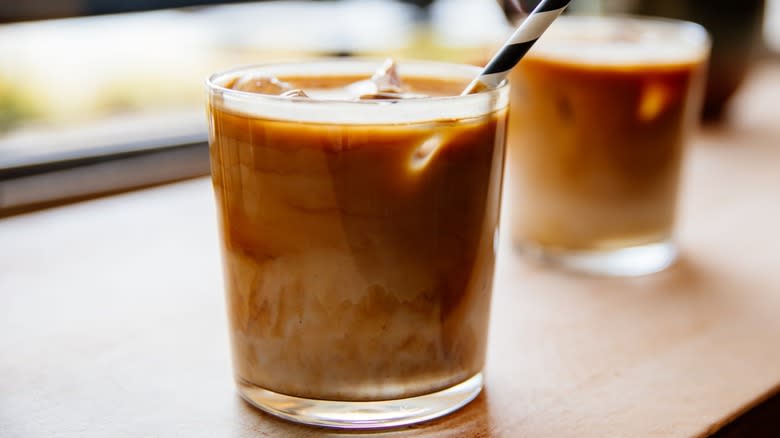The Key To Making A Perfectly Sweet And Smooth Iced Espresso Every Time

There's no wrong way to enjoy a shot of espresso. Served as a plain hot shot or iced with a dash of frothy whole milk, the only thing that matters is what you feel like drinking today. But if iced espresso is on the menu, then try out these tricks to get the best possible drink.
First, if you're going to sweeten your sip with sugar, add it into the cup first before pulling the shot. That way, when the inky espresso splashes into the cup, the heat plus the dripping action will melt the sugar right into the liquid without stirring. The hotter your espresso, the better the sugar will dissolve -- and at no point will your espresso be hotter than when it's right out of the machine.
The next step is to bring your sweetened espresso from piping hot down to warm by adding a splash of whole milk (if you like it black, you can use lukewarm water instead.) If you were to add the hot espresso right on top of the ice, it will just melt some of it and leave you with watery coffee. Some of the more delicate coffee flavor notes in your espresso would be lost before you even had the chance to try them. However, there's another reason why you should temper your iced espresso: To prevent temperature shock.
Read more: 26 Coffee Hacks You Need To Know For A Better Cup
Why Temperature Shock Can Ruin Your Espresso

Fresh hot espresso straight out of the machine will usually be between 160 and 165 degrees Fahrenheit. If you were to add it directly on top of the ice, the temperature would instantly plummet. This won't just make your brew more watery due to some of the ice melting when it comes into contact with the espresso, but -- chemically speaking -- the coffee's going to change, too.
Temperature shock destroys the lighter notes in your espresso, such as any fruity and chocolatey flavor elements that you get from good coffee. In their places, you'd have a strong smack of bitterness, almost like you just brewed over-extracted, too-fine espresso. If you've been making iced espresso for a while and are wondering why your drink doesn't taste quite like what you get at your local coffee shop, well, now you know.
The trick is to bring the temperature of the espresso down more gradually. As we mentioned earlier, you can first do that by tempering the coffee with either room-temp milk or water. After that, add your ice cubes -- but don't shovel a bunch into your espresso right away. Add one at a time, stirring carefully in-between each, so that the coffee has the chance to come down to temperature gradually. Do both steps correctly, the pre-sugaring and the tempering, and you'll have a perfectly sweet and smooth iced cup to start your morning.
Read the original article on Tasting Table

